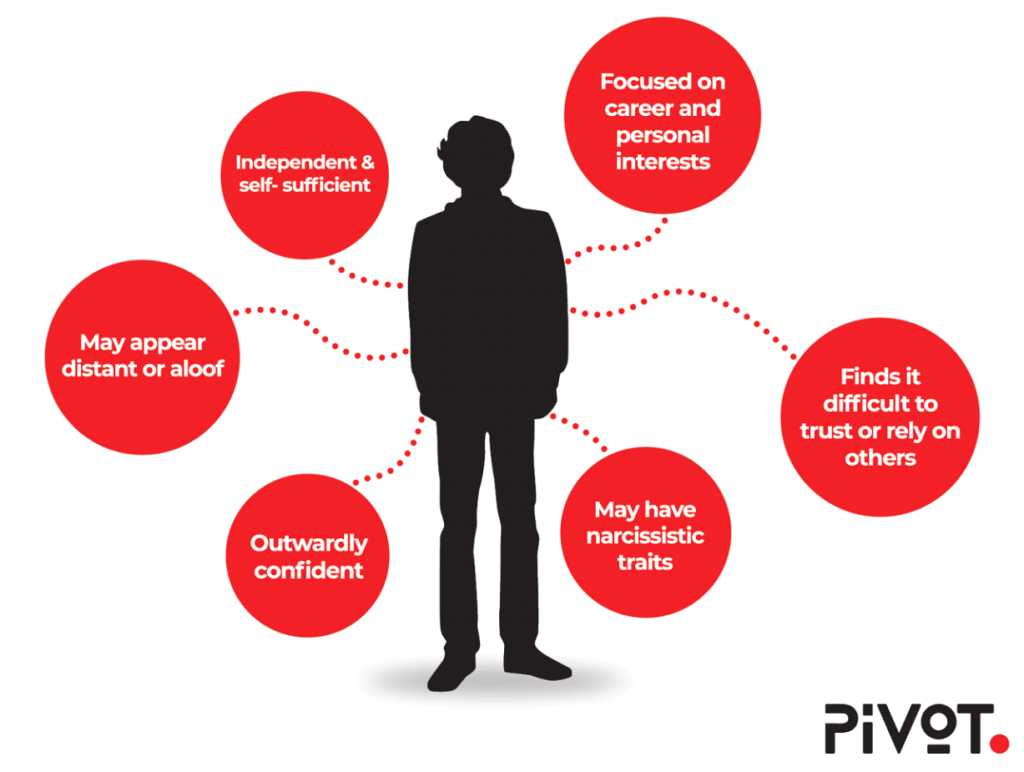On the surface, someone with an avoidant attachment style may seem independent, strong, and self-sufficient. They may seem like they aren’t ruled by emotions and tend to stay above the drama. However, in a relationship, an avoidant partner may be more reserved, less vulnerable, and even self-protective. This can cause confusion and increase conflict. And, if you are the avoidant partner, you may feel stifled and even uncomfortable with intimacy, leading to romantic blocks and dissatisfaction down the line.
Despite the challenges of the avoidant attachment style in relationships, it’s important to remember that change and growth are always possible. A partner with an avoidant attachment style may desire love, but they may also have a deep (conscious or unconscious) fear of intimate connections. Understanding this pattern and its origins is crucial for both those with avoidant attachment styles and their partners. Fortunately, there are ways for these individuals to navigate connections and build healthy, authentic relationships.
Characteristics of an Avoidant Attachment Style

How Is an Avoidant Attachment Style Formed?
Attachment style describes how an individual attaches to others in relationships, including romantic partnerships. It is significantly influenced by the emotional bonds infants form with their earliest caregivers. People generally develop a secure and healthy attachment style if their needs are met in infancy and childhood. However, if early needs are met inconsistently or incompletely, they are more likely to form an insecure attachment style.
People with an avoidant attachment style in relationships may have had caregivers who were emotionally distant, inconsistent, or dismissive of their needs. There may have been overt abuse and neglect, or their parent may have been unskilled or unable to meet their needs.
It’s crucial to understand that this attachment style developed as self-protection. Recognizing this can foster empathy and understanding in those with an avoidant attachment style and their partners, paving the way for healthier relationships.
How Can You Identify an Avoidant Attachment Style in Relationships?
Understanding how avoidant attachment affects relationships can prove extremely helpful for both partners. For the avoidant partner, it can be a valuable aid in identifying underlying factors and areas that need addressing. As for those who love someone with an avoidant attachment style, this knowledge can provide a fresh viewpoint. Having empathy and understanding for a person with an avoidant attachment style can help their partner approach the relationship in new, healthy ways.
Signs of an Avoidant Attachment Style in Relationships
| Coping Mechanism | How it Affects the Relationship |
| May have a limited emotional range |
|
| Values independence and self-sufficiency to a fault |
|
| Fears commitment |
|
Curious How You are Attaching in a Specific Relationship?
Can a Person With an Avoidant Attachment Style in Relationships Be a Good Partner?
The answer to this question is never black and white; like all things in life, it’s much more nuanced. In general, the success of the relationship lies in either the avoidant partner’s willingness to grow and adapt to a new dimension of emotional trust and safety or the partner of the avoidant person adapting their emotional expectations.
Avoidant behaviors (e.g., emotional withdrawal, commitment challenges, etc.) may have seemed protective in the past, but they normally do not benefit emotionally mature adult relationships. In fact, they often derail authentic connections.

Self-Awareness Is Key
The first step for someone with an avoidant attachment style to become a better partner is self-awareness. This starts with recognizing that while your survival patterns may have kept you safe, they may have also kept you lonely, disconnected, and unfulfilled. By recognizing avoidant tendencies and acknowledging harmful behavioral patterns, a person can begin to actively challenge them to “make room” for healthier emotional expression.
When an individual with an avoidant attachment style in relationships is ready for change, ideally, they will seek help along the way. A relationship coach can provide the scaffolding needed to make the heavy lifting possible. The right coach can not only help you or your partner revisit the past to identify the origins of protective behavior patterns but will also teach strategies for letting your guard down as you move forward. By opening up and expressing emotions in a safe space, it is possible to replace the coping mechanisms that have limited your relationship with sustainable strategies that forge secure and comfortable connections.
Overcome an Avoidant Attachment Style in Relationships With PIVOT
If you or your partner are trapped in a love-avoidance cycle, know that change is possible. A PIVOT-certified coach will provide the support needed to change your approach if you tend to have an avoidant attachment style in relationships. With this foundation, you can open up and create the solid connections you want and deserve.
Through the PIVOT process used in our individual coaching sessions and at our Glass House attachment retreat, you’ll find a safe space to recover your self-esteem and unravel the emotional barriers holding you back. Our experienced team is there to guide you every step of the way, offering personalized coaching that caters to your unique needs and challenges. Call us today at 1-855-452-0707 to start the healing journey.